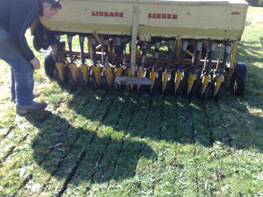In our quest to become dairy farmers we have leased a few acres in Gembrook to grow pasture and forage crops for our small herd. The land is run down pasture and I have outlined soil test results in the last few entries.
To get this pasture productive again we need to raise the pH, correct nutrient deficiencies and increase the soil health mainly through increasing organic matter.

Strategy: Make sure some legumes are included in the planting. Balance short term production and removal with longer term growth of pasture (persistance). Horse pasture, cut hay if possible but allow for some pasture suitable for horses to become established in the longer term for grazing. Perennial ryegrass, subterranean clover and cocksfoot. Hay pasture, mainly for hay cutting with some persistence into the next year. Italian ryegrass, balansa clover and cocksfoot. Forages for cows. This will be cut with a forage harvester and fed to cows. Oats, vetch and field peas. Sowing rate for the pasture mixes will be 25 kg / ha.
How much fertilizer? The major trace element deficiencies were boron and copper. We assumed that molybdenum could be deficient given the type of soil and history and because we wanted to establish legumes again we opted to include molybdenum. The final mix had 0.02% B, 0.01% Cu and 0.003% Mo.
We had CaCO3 lime added to the pastures in the previous autumn at 1 tonne / ha.
Unfertilized pasture will produce around 2 tonne / ha (as dry matter). Fertilized pasture can be expected to produce up to 10 t/ha maybe even higher for some varieties. Figures for nutrient uptake by different crops are hard to find and interpret but there are a few guideline figures available. We based calculations for fertilizer requirement on 8 t/ha. A harvested ryegrass / clover pasture (8 t/ha) will typically remove N : 104 kg/ha, P : 30 kg.ha, K : 102 kg/ha, S : 15 kg/ha, Ca : 17 kg/ha and Mg : 9.2 kg/ha. Our soil test results show that around 100 kg/ha DAP should supply enough P but not all the N required. Legumes in the pasture may help fill the gap. The DAP also contains sulphur so 100 kg/ha should supply all the S required. The soil is not short of calcium and magnesium for crop growth but we have limed the soil to reduce exchangeable acidity.
Ideally we would have preferred to apply phosphorus in a organic or organically coated form because this soil has the potential to lock up P. The decision to use DAP to supply nitrogen and phosphorus was a compromise but we figured that we had to balance fast short term growth against loss to the soil. However if things go well and organic matter increases in the soil some of that locked up P will be available again (see previous entries for a discussion on P in soils).
It is an expensive business to plant pasture especially to restore a pasture. To get a return we need to concentrate on quality as well as quantity of production. That’s why we opted to resow with productive varieties and to invest in fertilizer. Also there needs to be some carry over of growth so not all the pasture needs to be resown the next year. Our strategy is to keep something growing and includes allowing some production to return to the soil. Basically that means we are preserving and enhancing our capital.
Diversity is important. That’s why we opted to include at least Cocksfoot in the mix – maybe when we better understand the potential and problems with other varieties they can be included also.
In Spring 2014 we sprayed the existing pasture with a low strength glyphosate spray. This was to weaken the weeds and reduce competition without unduly affecting existing grasses.

Most small seeded pasture varieties can be sown along with fertilizer with a spreader but this needs to be followed by a pass with pasture harrows and maybe a roller to help bury the seed. A direct drill seeder with either discs or tines is designed to bury the seeds along with the fertilizer. The main advantages of this are more efficient sowing where the fertilizer is placed with the more desirable species, ability to sow larger seeded varieties in the soil away from pests and less disturbance of the soil – particularly important where exposed soil can dry out. Settings on the seeder regulate the flow of seed and fertilizer but every now and again it helps to jump off the tractor to check that the seed and fertilizer is being released at a suitable rate.